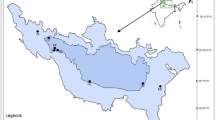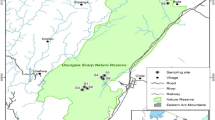Abstract
The purpose of the paper is (a) to describe the distribution pattern of tiger beetles in Shorea robusta dominated forest ecosystems at landscape level of north western Shivalik Himalaya in environmental space and (b) to evaluate the nature of microhabitat association amongst recorded species of tiger beetles. Twenty-five species of tiger beetles belonging to ten genera were recorded from six protected areas in the tropical dry deciduous Shivalik region with an altitudinal gradient of 350–1,400 m above mean sea level in north western India. Sampling for tiger beetles was carried out using strategically designed sample plot in ten distinct habitat types with five collection methods employed. Species composition of tiger beetles varied significantly between microhabitat types of the protected areas (Shannon H′ = 0.436–1.069) and habitat specialists were found in only few of habitats. Bray–Curtis cluster analysis clustered the ten habitats into five cluster groups based upon the species composition with Shorea robusta most distinct from agricultural habitats. Riverine area was found to be the most diverse (with 18 or 72% of total species) as well as abundant (457 ± 33.61 SE individuals recorded per sample plot). Khair, Syzygium and pine forests were least rich and had only three species each. Two species J. crassipalpis and M. melancholica were found only in riverine habitat. Though late summer to mid-monsoon was found most favorable for tiger beetles, only one species, C. chloris was persistently found even during modest winter months. Bulla’s diversity index showed that habitat breadth of species ranged from 0.00 to 6.66, an indicative of their habitat restrictiveness. Indicator species analysis revealed as many as 14 species indicative of particular habitat conditions. Descriptions of some important ecological and behavioral aspects are included for these species. The observed C-score (299.43330) showed that there is less co-occurrence among species pairs alongwith lower niche overlap (Pianka’s index = 0.14191) thereby illustrating ample resource partitioning at microhabitat level. Further, co-occurrence index among guilds (C-score = 213.16250 with variance 1,949.76300) was found to be smaller than expected, revealing that feeding guilds are differing significantly from one another in their levels of co-occurrence. Canonical correspondence analysis identified canopy cover, litter and average tree density as the most important habitat variable defining the distribution of tiger beetles in environmental space. Such assemblage patterns among species of tiger beetle would thus provide a solid basis to interpret changes in microclimatic conditions, caused by humans directly or through long term climate change and would thus help establishing a baseline in long term monitoring of these forest ecosystems.








Similar content being viewed by others
References
Acciavatti RE, Pearson DL (1989) The tiger beetle genus Cicindela (Coleoptera, Insecta) from the Indian Subcontinent. Ann Carnegie Mus 58:77–353
Bhargav V, Uniyal VP (2008) Communal roosting of tiger beetles (Cicindelidae: Coleoptera) in the Shivalik hills, Himachal Pradesh, India. Cicindela 40:1–12
Bouyoucos GJ (1962) Hydrometer method improved for making particle size analysis for soils. Agron J 54:464
Bulla L (1994) An index of evenness and its associated diversity measure. Oikos 70:167–171
Camargo JA (1995) On measuring species evenness and other associated parameters of community structure. Oikos 74:538–542
Carroll SS, Pearson DL (1998) Spatial modeling of butterfly species richness using tiger beetles (Cicindelidae) as a bioindicator taxon. Ecol Appl 8:531–543
Cassola F, Pearson DL (2000) Global patterns of tiger beetle species richness (Coleoptera: Cicindelidae): their use in conservation planning. Biol Conserv 95:197–208
Caughlan L, Oakley KL (2001) Cost considerations for long-term ecological monitoring. Ecol Indic 1:123–134
Curtis JT (1959) The vegetation of Wisconsin. An ordination of plant communities. University Wisconsin press, Wisconsin
DeBach P (1966) The competitive displacement and coexistence principles. Ann Rev Entomol 11:183–212
Desender K (1989) Loss of habitats and changes in the composition of the ground and tiger beetle fauna in four western European countries since 1950 (Coleoptera: Carabidae, Cicindelidae). Biol Conserv 48:277–294
Dufrene M, Legendre P (1997) Species assemblages and indicator species: the need for a flexible asymmetrical approach. Ecol Monogr 67:345–366
Faith KH, Young TP, Carreiro MM (1998) Forest leaf litter quantity and seedling occurrence along an urban-rural gradient. Urban Ecosyst 2:263–278 Kluwer
Fanelli G, Tescarollo P, Testi A (2006) Ecological indicators applied to urban and suburban floras. Ecol Indic 6:444–457
Fox BJ (1987) Species assembly and the evolution of community structure. Evol Ecol 1:201–213
Fox BJ (1999) The genesis and development of guild assembly rules. In: Weiher E, Keddy P (eds) Ecological assembly rules: perspectives, advances retreats. Cambridge University Press, Cambridge, pp 23–57
Fox BJ, Brown JH (1993) Assembly rules for functional groups in North American desert rodent communities. Oikos 67:358–370
Fränzle O (2006) Complex bioindication and environmental stress assessment. Ecol Indic 6:114–136
Gaston AJ (1985) Report on a visit to Pong Dam Lake, 2–3 December. Canadian Wildlife Service, Ottawa
Gaston AJ (1986) West Himalayan wildlife survey. Report on activities in 1985
Glowka L, Burnhenne-Guilmin F, Synge H, Mc Neely JA, Gündling L (1994) A guide to the convention on biological diversity. IUCN, Gland
Gotelli NJ, Entsminger GL (2001) EcoSim: null models software for ecology. Version 7.0. Acquired intelligence inc. and Kesey Bear. Online at http://homepages.together.net/~gentsmin/ecosim.htm
Hadley NF, Knisley CB, Schultz TD, Pearson DL (1990) Water relations of tiger beetle larvae (Cicindela marutha): correlations with habitat microclimate and burrowing activity. J Arid Environ 19:189–197
Hilden M, Rapport DJ (1993) Four centuries of cumulative impacts on a Finnish river and its estuary; an ecosystem health approach. J Aquat Ecosyst Health 2:261–275
Kremen C, Colwell RK, Erwin TL, Murphy DD, Noss RF, Sanjayan MA (1993) Terrestrial arthropod assemblages: their use in conservation planning. Conserv Biol 7:796–808
Kuliopulos H (1990) Amazonian biodiversity. Science 248:1305
Landres PB, Verner J, Thomas JW (1988) Ecological uses of vertebrate indicator species: a critique. Conserv Biol 2:316–328
McAleece N, Lambshead PJD, Paterson GLJ (1997) Natural history museum and the Scottish association for marine Science. http://www.nhm.ac.uk/zoology/bdpro
McCune B, Mefford MJ (1999) Multivariate analysis of ecological data, version 4.26.MjM Software Design. Gleneden Beach, Oregon
Montreal Process (2000) Montreal Process Year 2000. Progress report: progress and innovation in implanting criteria and indicators for the conservation of sustainable management of temperate and boreal forests. The Montreal Process Liaison Office, Canadian Forest Service, Ottawa, Canada
Naviaux R (1994) Les Collyris (Coleoptera, Cicindelidae): révison de genres et description de nouveaux taxons. Soc linn de Lyon 63:106–290
Naviaux R (2002) Les Tricondylina (Coleoptera, Cicindelidae): révison de genres Tricondyla Latreille et Derocrania Chaudoir et descriptions de nouveaux taxons. Soc entomol France 5:1–106
Noss RF (1990) Indicators for monitoring biodiversity: a hierarchical approach. Conserv Biol 4:355–364
Pearson DL (1988) Biology of tiger beetles. Ann Rev Entomol 33:123–147
Pearson DL (1994) Selecting indicator taxa for the quantitative assessment of biodiversity. Philos Trans R Soc London B 345:75–79
Pearson DL, Anderson JJ (1985) Perching heights and nocturnal communal roosts of some tiger beetles (Coleoptera: Cicindelidae) in southeastern Perú. Biotropica 17:126–129
Pearson DL, Carroll SS (1998) Global patterns of species richness: spatial models for conservation planning using bioindicator and precipitation data. Conserv Biol 12:809–821
Pearson DL, Carroll SS (2001) Predicting patterns of tiger beetle (Coleoptera: Cicindelidae) species richness in northwestern South America. Stud Neotrop Fauna Environ 36:123–134
Pearson DL, Cassola F (1992) Worldwide species richness patterns of tiger beetles (Coleoptera: Cicindelidae): indicator taxon for biodiversity and conservation studies. Conserv Biol 6:376–391
Pearson DL, Ghorpade K (1989) Geographical distribution and ecological history of tiger beetles (Coleoptera: Cicindelidae) of the Indian subcontinent. J Biogeogr 16:333–344
Pearson DL, Mury EJ (1979) Character divergence and convergence among tiger beetles (Coleoptera: Cicindelidae). Ecology 60:557–566
Pearson DL, Vogler P (2001) Tiger beetles: the evolution, ecology, and diversity of the cicindelids. Cornell University Press, Ithaca
Pianka ER (1973) The structure of lizard communities. Ann Rev Ecol System 4:53–74
Pielou EC (1969) An introduction to mathematical ecology. Wiley, New York
Pyle R, Bentzien M, Opler P (1981) Insect conservation. Ann Rev Entomol 26:233–258
Rapport DJ, Singh A (2006) An ecohealth-based framework for state of environment reporting. Ecol Indic 6:409–428
Rapport DJ, Costanza R, Epstein P, Gaudet C, Levins R (eds) (1998) Ecosystem Health. Blackwell Science, Oxford
Rodgers WA, Panwar HS, Mathur VB (2002) Wildlife protected area network in India: a review, Wildlife Institute of India, Dehradun
Rodriguez JP, Pearson DL, Barrera RR (1998) A test for the adequacy of bioindicator taxa: are tiger beetles (Coleoptera: Cicindelidae) appropriate indicators for monitoring the degradation of tropical forests in Venezuela? Biol Conserv 83:69–76
Rosenberg DM, Danks HV, Lehmkuhl DM (1986) Importance of insects in environment impact assessment. Environ Manag 10:773–783
Shannon CE, Weaver W (1949) The mathematical theory of communication. University of Illinois Press, Urbana
Sinu PA, Nasser M, Rajan PD (2006) Feeding fauna and foraging habits of tiger beetles found in agro-ecosystems in western ghats, India. Biotropica 38:500–507
SPSS 16.0 (2007) for Windows, Rel. 09.13. Chicago: SPSS Inc
Stone L, Roberts A (1990) The checkerboard score and species distributions. Oecologia 85:74–79
Suter GW (2001) Applicability of indicator monitoring to ecological risk assessment. Ecol Indic 1:101–112
ter Braak CJF (1986) Canonical correspondence analysis: a new eigenvector technique for multivariate direct gradient analysis. Ecology 67:1167–1179
ter Braak CJF, Verdonschot PFM (1995) Canonical correspondence analysis and related multivariate methods in aquatic ecology. Aquat Sci 57:255–289
Uniyal VP, Bhargav V (2007) Tiger beetles–a field study in the Shivaliks of Himachal Pradesh. Wildlife Institute of India, Dehradun
Walkley AJ, Black TA (1934) Estimation of soil organic carbon by the chromic acid titration method. Soil Sci 37:29–38
Wiesner J (1992) Verzeichnis der Sandlaufkäfer der Welt. Checklist of the tiger beetles of the world (Coleoptera, Cicindelidae). Verlag Erna Bauer, Keltern
Acknowledgments
We are thankful to the Director and Dean, Wildlife Institute of India and Himachal Pradesh forest department for necessary financial, logistical support and permissions to carry out the study. Thanks to Dr. P K. Mathur, Department of Landscape Level Planning and Management for suggestions and guidance to undertake the study in Shivalik landscape. We are also thankful to Drs. P. Tiwari and H.R. Pajni, Punjab University, Chandigarh, for identification of tiger beetles and Mr. Upamanyu Hore for fruitful discussions on statistical analyses. R. Padmawathe and Swati Kittur carried out the initial fieldwork under the project. Dr. D. L. Pearson, Arizona State University, Arizona, USA, critically reviewed several drafts of this article. The Department of Science and Technology (DST), Ministry of Science and Technology, Government of India and Ministry of Human Resource Development Group-Council for Scientific and Industrial Research (HRDG-CSIR) funded this research. We are also grateful to two anonymous referees for their constructive comments that were of great help in finalizing the article.
Author information
Authors and Affiliations
Corresponding author
Rights and permissions
About this article
Cite this article
Bhargav, V., Uniyal, V.P. & Sivakumar, K. Distinctive patterns in habitat association and distribution of tiger beetles in the Shivalik landscape of North Western India. J Insect Conserv 13, 459–473 (2009). https://doi.org/10.1007/s10841-008-9193-y
Received:
Accepted:
Published:
Issue Date:
DOI: https://doi.org/10.1007/s10841-008-9193-y




